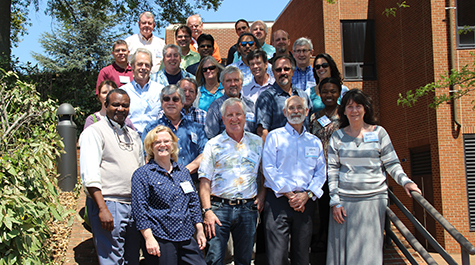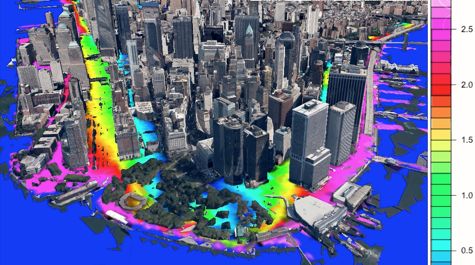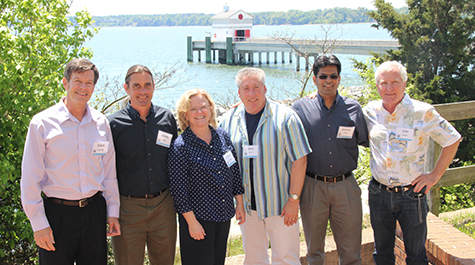Marine lab leaders discuss sea-level rise at VIMS
Representatives from marine laboratories throughout the southern U.S. traveled to the Virginia Institute of Marine Science last week for their annual meeting and to discuss an issue—sea-level rise—that threatens not only coastal communities but many of the lab’s own waterfront campuses.
The meeting of the Southern Association of Marine Laboratories—a regional branch of the National Association of Marine Laboratories—is hosted by a different member-campus each year. SAML members range from Maryland to Texas, as well as Bermuda, Panama, and the U.S. Virgin Islands. In addition to VIMS, members include Duke University Marine Laboratory (North Carolina), Mote Marine Laboratory (Florida), Dauphin Island Sea Laboratory (Alabama), and the Louisiana Universities Marine Consortium.
Dr. Linda Schaffner, VIMS’ Associate Dean of Academic Studies and SAML member-at-large, says, “SAML provides an excellent opportunity for members to share information on best practices, as well as the diverse challenges we face in advancing marine research, education, and advisory service at our labs. When I have a question, there is usually a SAML colleague I can call on for information or advice. That sort of networking and communication allows us all to work smarter.”
A SAML member since 1990, VIMS was hosting the meeting on its Gloucester Point campus for the second time. SAML President Louis Burnett—an alumnus of William & Mary’s School of Marine Science at VIMS and now a professor at the College of Charleston’s Grice Marine Lab—says the annual meeting provides members the opportunity to meet face-to-face and renew and make acquaintances. “Each lab in each region has special challenges,” he says. “However, there are many common issues we all face.”
For this year’s meeting, participants chose to discuss sea-level rise and coastal resilience, with VIMS Dean and Director John Wells and Associate Dean of Advisory Service Mark Luckenbach gathering an esteemed group of experts to shed light on the topic.
“Ready access to the water is an obvious need for a marine lab,” says Wells, “but it also puts us at the frontline of sea-level rise. We’re already taking steps to deal with and plan for the impacts of higher water on our own campus, and continue to share knowledge, tools, and techniques with our fellow labs and with localities nationwide.”
Morris Foster, Vice President for Research at Old Dominion University, kicked off the meeting discussion by introducing attendees to ODU’s Hampton Roads Sea Level Rise Preparedness and Resilience Intergovernmental Planning Pilot Project, an initiative to foster coordination among Federal, state, and local government agencies, as well as the private sector.
Foster explained the current and predicted impacts of sea-level rise in Hampton Roads, and warned of serious consequences if effective preparedness and resilience measures are not put into place in the near future.
Retired U.S. Navy Captain Eric Jabs reviewed the Navy’s resiliency planning, while Roy Hoagland, Director of William & Mary’s Coastal Policy Clinic, discussed the legal and policy issues that surround resiliency planning. Katherine Rowan, professor of communication at George Mason University, shared effective methods for communicating the risks of sea-level rise to citizens and policymakers.
VIMS professors Harry Wang and Matt Kirwan closed the discussion by presenting recent advances in their sea-level-rise research. Wang introduced SAML members to his new high-resolution computer model, which can predict a hurricane’s storm tide at the level of individual neighborhoods and streets. He showed that—with the right input—the model was able to simulate water levels to within 6-8 inches of those observed in New York City and surrounding areas during Hurricane Sandy’s approach and landfall in 2012.
Kirwan—a Chesapeake Bay marsh expert who joined the VIMS faculty in 2013—discussed the resilience of tidal marshes in the face of sea-level rise. He explained that the focus of his research is to better understand how wetlands respond to rising seas, carbon-dioxide levels, and temperature; how humans influence wetlands even more directly through changes in sediment supply; and how climate-mediated changes in wetland dynamics affect the ability of these ecosystems to store carbon.
In addition to the session on sea-level rise, the members also discussed national education statistics for the field of marine science and considered ways that marine labs and academic programs can enhance the diversity of students and faculty at their institutions.
“This year’s meeting was special for a number of reasons,” says Burnett. “This is the 30th anniversary of SAML, which corresponds with the 75th anniversary of VIMS.” He notes also that at least six of the delegates from SAML member institutions are alumni of William & Mary and/or VIMS.





